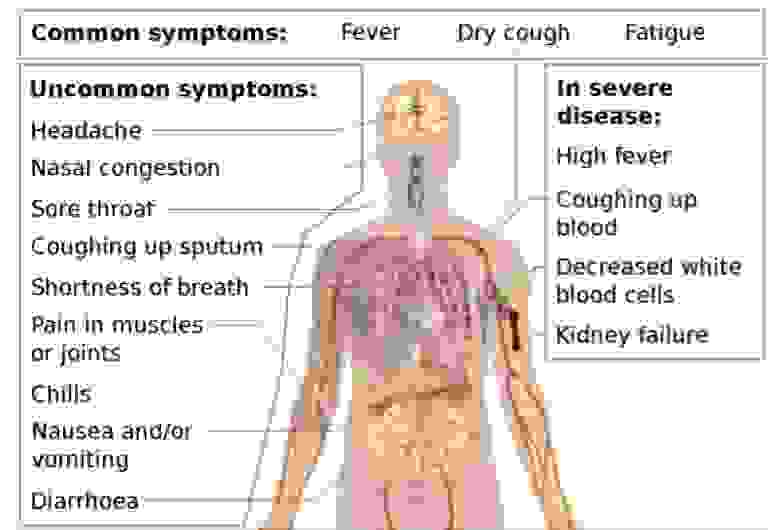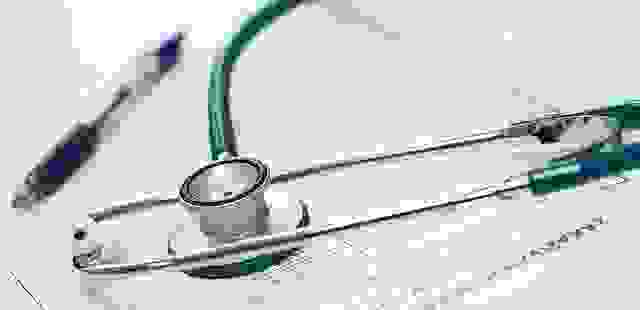This is what coronavirus does to your body

The virus can enter the body through eyes, nose or mouth and when the virus penetrates the epithelial cells of the respiratory tract, it will use these cells to make copies of itself. The copies can in turn infect new cells. For the majority of people, the symptoms are mild but for some, the infection may result in a complete failure of the lungs.
In the beginning, when the viruses enter the body, one does not feel anything. Only after viruses have managed to make enough copies of themselves, and the body’s immune system starts to react, the symptoms of the infection start to show.
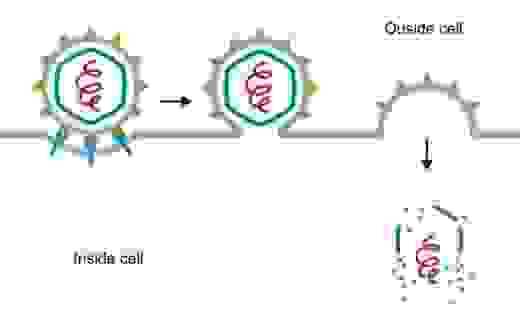
At this stage, the conquered cells have raised an alarm to alert the body’s immune system to combat the intruders. The mobilization of the immune system causes the body to react against the infection through various mechanisms. The overall damage to the body may then be caused by both virus infection itself and also the body’s own defense mechanisms.
Video [2:19]. A short animation of coronavirus entering inside body and fusing with a cell.
The infection in the lungs will hamper their function by an increased number of cells being infected and an increasing amount of fluid filling the lungs; thus, limiting the lung’s ability to deliver oxygen to the blood circulation. In the worst case, the infection will result in acute respiratory distress syndrome (ARDS) causing shortness of breath and bluish skin color. See common and uncommon syptoms. The survivors will often experience a decreased quality of life.
A person will experience symptoms when the infection is enough wide-spread. Coughing is common to clear mucus from the lungs. The body’s reaction against the infection causes fever. Muscle pain and headache are the side effects body’s reaction against the infection and are common even with common flu.
Cause for diarrhea
The virus may migrate from the throat to the intestine and cause infection which could explain diarrhea. In rare cases, the viruses may get all the way to the heart, liver, bone marrow, and kidneys causing an infection there.
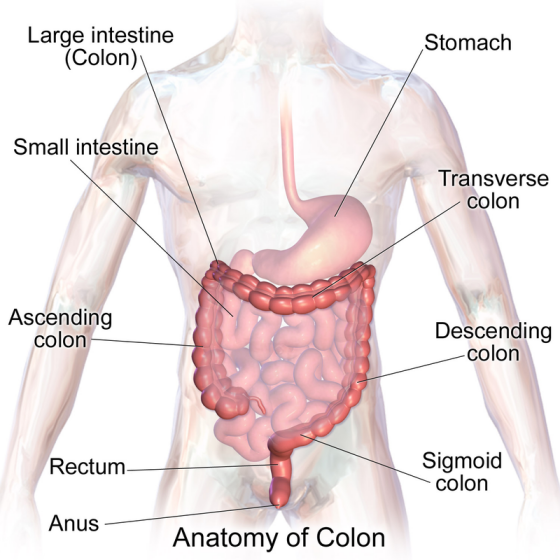
The incubation time varies from five days to two weeks from the infection. Most of the people will experience only mild symptoms but for some cause a prolonged period of illness
Severe symptoms are rare for children and young people but for older individuals, the risk of death is increased. The overall death rate varies from 1% to 5% depending on the country, demography, and particular estimation. In China, every fifth person of confirmed cases over 80 years died and about 14% of the cases were severe while 81% of the cases were mild.
There are two known separate strains of COVID-19. One more aggressive than the other. Viruses also mutate over time and usually for being increasingly mild because killing the host restricts their spreading. Only the time will tell how this all will develeop and hopefully end soon.The timeline of COVID-19 symptoms from the beginning of the infection
-
5 days The incubation time
The incubation time varies from five days to two weeks. In the beginning, patients will have a cough and fever, experience fatigue, muscle pain, and headache. Most often the symptoms are mild even for those who have caught mild pneumonia.
-
12-19 days Symptoms worsen
The incubation time varies from five days to two weeks. In the beginning, patients will have a cough and fever, experience fatigue, muscle pain, and headache. Most often the symptoms are mild even for those who have caught mild pneumonia.
-
13-14 days Possible ARDS
The most serious consequence of pneumonia is acute respiratory distress syndrome (ARDS) that may have begun on average eight to nine days from the beginning of the symptoms
-
19 days Possible death
On average 1% to 5% will die approximately two weeks after the start of the symptoms. The disease outcome is conditional to age, income, access to healthcare, access to respirators, pre-existing conditions, and probably smoking status.
A 360° Virtual Reality fly-through showing the extent of damage to the lungs (yellow) from COVID-19 for a patient seen by Dr. Keith Mortman at George Washington University Hospital. Made with Surgical Theater technology. The damage is irreversible.
See also Comparison of symptoms, COVID-19, influenza, cold
- - -
You may also be interested in the following
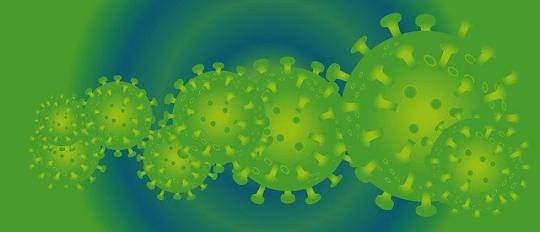
Do we need to protect Pets from COVID-19?
Which pets can get infected by COVID-19? Do we need to isolate ourselves from our pets? Read more
The Deadliest Infectious Diseases
All the statistics and news readily available on the Internet has made us all aware of the number of people dying every minute, hour, and day. During the past pandemics, we didn't have online access to such information. Is Nature Out To Kill Us? Read more
What is Wuhan-400 bioweapon?
It was around then that a Chinese scientist named Li Chen defected to the United States, carrying a diskette record of China’s most important and dangerous new biological weapon... Read more
Is the eyes of darkness a prophecy?
What does it have to do with the coronavirus outbreak? Read more
Coronavirus movies
Top 10 movies related to coronavirus. How can we lighten up amid pandemic fears? A day out to see a movie will be nice but you probably will prefer to stay at home to avoid catching the virus. Read more
Career Outlook: Data and Bioinformatics Scientists to 2026
Degree vs. Skills: Impact on salary
Bioinformatics and data science vacancies
Spicy Food may protect you from cerebral infarction and make you live longer
References
Liu K, Chen Y, Lin R, Han K. "Clinical feature of COVID-19 in elderly patients: a comparison with young and middle-aged patients." J Infect. 2020;S0163-4453(20)30116-X. doi: 10.1016/j.jinf.2020.03.005.
Ye G, Pan Z, Pan Y, et al. "Clinical characteristics of severe acute respiratory syndrome coronavirus 2 reactivation." J Infect. 2020;S0163-4453(20)30114-6. doi: 10.1016/j.jinf.2020.03.001.
Wu D, Wu T, Liu Q, Yang Z. "The SARS-CoV-2 outbreak: what we know." Int J Infect Dis. 2020;S1201-9712(20)30123-5. doi: 10.1016/j.ijid.2020.03.004.
Shi F, Yu Q, Huang W, Tan C. "2019 Novel Coronavirus (COVID-19) Pneumonia with Hemoptysis as the Initial Symptom: CT and Clinical Features." Korean J Radiol. 2020. doi: 10.3348/kjr.2020.0181.
Cheng Z, Lu Y, Cao Q, et al. "Clinical Features and Chest CT Manifestations of Coronavirus Disease 2019 (COVID-19) in a Single-Center Study in Shanghai, China." AJR Am J Roentgenol. 2020;1–6. doi: 10.2214/AJR.20.22959.
Salehi S, Abedi A, Balakrishnan S, Gholamrezanezhad A. "Coronavirus Disease 2019 (COVID-19): A Systematic Review of Imaging Findings in 919 Patients." AJR Am J Roentgenol. 2020;1–7. doi: 10.2214/AJR.20.23034.
Ai JW, Zhang Y, Zhang HC, Xu T, Zhang WH. "Era of molecular diagnosis for pathogen identification of unexplained pneumonia, lessons to be learned.." Emerg Microbes Infect. 2020;9(1):597–600. doi: 10.1080/22221751.2020.1738905.
Sriwijitalai W, Wiwanitkit V. "Positive Screening for Wuhan Novel Coronavirus Infection at International Airport: What's the Final Diagnosis for Positive Cases.." Int J Prev Med. 2020;11:30. Published 2020 Feb 21. doi: 10.4103/ijpvm.IJPVM_42_20.
Wang Z, Yang B, Li Q, Wen L, Zhang R. "Clinical Features of 69 Cases with Coronavirus Disease 2019 in Wuhan, China. ." Clin Infect Dis. 2020 Mar 16:ciaa272. doi: 10.1093/cid/ciaa272.
Huang C, Wang Y, Li X, et al. (2020) "Clinical Features of Patients Infected With 2019 Novel Coronavirus in Wuhan, China." Lancet. 2020;395(10223):497–506. doi: 10.1016/s0140-6736(20)30183-5

